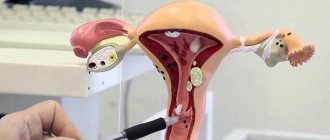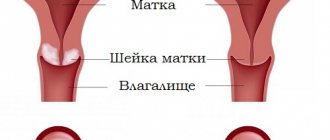Purpose of the obstetric ring
After the 20th week of pregnancy, as a result of the growth of the fetus, additional pressure occurs on the walls of the uterus, which leads to its opening. Many women are not aware of this pathology before pregnancy; this abnormality is diagnosed during an examination by a gynecologist.
If complications arise, a pessary is placed on the cervix in order to prolong the gestation period and maintain the pregnancy. Its action is determined as follows:
- closes the cervix due to its design, does not allow it to relax;
- reduces libido;
- helps preserve the mucus plug;
- affects the distribution of intrauterine pressure between the walls;
- reduces the load on the weakened cervix, shifting the pressure on it from the growing fetus.
In addition, this procedure gives the woman additional confidence in her ability to safely carry the fetus, which has a positive effect on her mental state.
You can also strengthen the cervix by placing sutures on it. This procedure is performed under anesthesia, so it can be used after the 20th week of pregnancy. Installation of a pessary is more harmless and, if necessary, can be performed at an earlier date.
Indications for installing a pessary on the cervix
- to exclude miscarriage or premature labor in patients who have previously repeatedly encountered this problem;
- in case of pregnancy that occurs after a long period of trying to get pregnant, in older women with impaired ovarian function;
- pregnant women at a very young age;
- for gynecological diseases that provoke shortening of the cervix and its dilatation;
- women whose pregnancy is associated with heavy physical activity;
- if there are scars on the cervix or its deformed structure;
- pregnant women whose emotional state is close to a nervous breakdown due to fears of losing a child;
- if there is more than one fetus in the uterus;
- isthmic-cervical insufficiency, a disease in which, due to increasing stress during fetal growth, the cervix is able to open, causing miscarriage.
Contraindications:
- bloody vaginal discharge, especially after the 24th week;
- inflammatory processes in the female genital organs, requiring appropriate treatment;
- pathology of fetal development, in which termination of pregnancy is indicated;
- suspicion of a frozen fetus.
Which is better: sutures or pessary
Previously, only a surgical method was used to correct ICI - a suture was placed on the neck. However, this invasive technique was replaced by a gentle decision on the possibility of installing a special fixing device. This method has the following positive features compared to surgical correction:
- non-invasive;
- reducing the risk of infection;
- the possibility of installation in an outpatient setting (that is, there is no need for hospitalization);
- no need for anesthesia;
- ease of installation;
- absence of traumatic effects on the cervix and amniotic sac, that is, absence of a stimulating effect on labor;
- less frequent development of disturbances in the natural balance of vaginal flora.
However, you need to understand that some clinical situations may require suturing with subsequent installation of the uterine ring, that is, there is not always a need for surgical correction measures.
The appropriateness of both methods is determined by the doctor depending on the clinical situation and the presence of contraindications, so it is impossible to unequivocally answer the question of which is better: sutures or a pessary.
Installation procedure and maintenance
Before installing the device, you must ensure that there is no infection in the woman’s genital tract. If such signs are detected, it is recommended to carry out treatment before performing the procedure, and only after that carry out the installation of a pessary.
The procedure for installing a pessary takes only a few minutes and is carried out by a specialist on a gynecological chair, with an empty bladder. The ring is pre-lubricated to improve glide, passed through the vagina and placed on the cervix.
Painful sensations appear in rare cases; this process is generally painless, with minor manifestations of discomfort. Anesthesia is not used, the patient does not report acute pain. An exception may be the high sensitivity of the uterus or its being in good shape, while it is possible to take antispasmodics before the manipulation.
The device requires special care. A woman should follow certain rules:
- Visit your gynecologist regularly to monitor the placement of the pessary and prevent possible complications.
- Do not try to change the position of the device or remove it yourself.
- Monitor the condition of the vaginal microflora and take a smear for examination.
- To prevent the development of sexually transmitted infections, it is possible to use vaginal medications.
- Stay calm and avoid physical activity.
- Avoid sexual contact.
A pessary is placed on the cervix after 20 weeks. The threat of premature labor worsens after 28 weeks and may be an indication for manipulation. After the 35th week, the complete formation of the fetus ends, the installation of a pessary to support the cervix is no longer recommended.
Pessary during pregnancy: photo reviews, when to put it in, take it off, does it hurt?
Sometimes doctors find out that a woman will have to get a pessary during pregnancy. Yes, there is nothing pleasant about it, but sometimes installing a vaginal ring is simply necessary. Thanks to this device, a woman will be able to safely carry a child.
Photos: why During pregnancy, painful sensation when changing position Disturbance in nature, woman during pregnancy is comfortable
The device has justified itself, because thanks to it, in approximately 90% of cases, it is possible to prolong pregnancy to its due date. More recently, instead of a ring, it was necessary to put stitches on the cervix. The operation required anesthesia, which can have negative consequences.
A gynecological pessary installed during pregnancy is often called a ring because of its shape. However, modern devices are very diverse and differ in appearance, shape and purpose.
You need to know that the device is used not only in gynecology and obstetrics, but also, for example, in urology. There are special urological rings.
Also read about badger fat in the 1st trimester of pregnancy and the dangers of increased protein in the urine.
During pregnancy, a silicone or plastic pessary is installed. Don’t be afraid, because this device will not interfere with the baby’s development. On the contrary, it will make the process of bearing a fetus as comfortable as possible. The devices vary in shape.
There are:
- donut type;
- mushroom-shaped;
- cup;
- stripes;
- cubic;
- round;
- oval.
In addition, devices come in several types: obstetric, therapeutic, pharmaceutical. Each of them is used for a specific purpose.
| View | What is it used for? |
| Obstetric | Correction of the position of the cervix to avoid pre-labor. |
| Therapeutic | Uterine prolapse, uterine flexion, urinary incontinence, bladder hernia. |
| Pharmaceutical | Introduction of medications into the vagina. |
Only purchased from a pharmacy
What is the remedy for?
Let us dwell in more detail on why exactly a pessary is needed during pregnancy. The fact is that not all expectant mothers fully understand this. Not much evidence:
- suture failure after surgical treatment of isthmic-cervical insufficiency;
- prevention of ICN.
These are exactly the conditions where the cervix is very soft or short and therefore dilates prematurely, causing miscarriage or labor.
Sometimes necessary for prevention
The ring allows you to preserve the process of bearing a child and prolong a pregnancy that is in danger of failure. Often the device has to be installed when carrying twins or triplets. It prevents premature birth in women diagnosed with ICI and those carrying multiple pregnancies. However, this device should not be the only treatment for ICI.
An unloading obstetric pessary allows you to keep the cervix closed, relieve tension from it and prevent premature softening. In addition, the pressure on the cervix is reduced.
Many women are very worried when they are prescribed a pessary during pregnancy, look for photos of the device on the Internet and read reviews of those who have encountered the same problem. At the same time, it is with the obstetric ring that the process of bearing a baby will go smoothly.
However, there are several contraindications to ring installation. First of all, there is a suspicion of a frozen pregnancy. In addition, the procedure is prohibited if an inflammatory process appears in the genitals, or if bloody discharge appears from the vagina.
Features of device installation
Previously, it was possible to suture the uterus only from the 20th week of pregnancy, since anesthesia had to be used. Nowadays, pessary installation is possible during earlier pregnancy. You just need to choose a certain type of ring. But most often the device is installed after 20 weeks. Usually between 28 and 33 weeks.
First of all, it is necessary to prepare the genital tract. To do this, it is necessary to carry out sanitation.
If there is any infection (thrush, for example), it will worsen while wearing the ring. Usually, the doctor prescribes vaginal suppositories for treatment or prevention, and only after that the vaginal ring is installed.
Probably every woman is interested in how exactly the doctor will place a pessary during pregnancy. The procedure is simple and takes minimal time. It will take literally a few minutes. The woman empties her bladder and then sits in the gynecological chair.
The doctor carefully inserts the ring through the vagina and installs it, after bending it. Before installation, the ring is lubricated with glycerin or any other moisturizer to facilitate its insertion into the vagina by increasing slip.
Woman feels discomfort when moving
Everyone’s sensitivity threshold is different, so during pregnancy, some girls will think about whether it hurts to put on an obstetric pessary. Sometimes girls report severe pain, but doctors say that this is normal discomfort and psychosomatics. The discomfort, although unpleasant, is bearable.
If the uterus is toned or highly sensitive, then half an hour before the procedure you need to take an antispasmodic. This will make it easier to move the installation of the ring. Doctors do not use anesthesia for this procedure. During pregnancy, a woman usually does not experience pain after installing a pessary.
It is necessary to pay special attention to the care of the device. After installation, the doctor tells the woman exactly how to care for the pessary during pregnancy. First of all, you need to maintain physical peace. Having sex is prohibited. Sometimes you have to use vaginal suppositories to prevent the development of sexually transmitted infections.
The doctor must monitor the condition of the vaginal microflora, so a smear is taken every 3 weeks. You will also have to regularly go for a gynecological examination so that the doctor monitors the correct placement of the device and possible complications. You should not touch the pessary yourself or try to adjust or remove it.
Can the ring fall off?
The expectant mother will feel the ring when changing position
Usually women quickly get used to vaginal rings. They do not cause discomfort and are almost not felt. However, during pregnancy, many people worry about whether the ring (pessary) might fall off. Yes, this happens. But this is rather an exception to the rule.
Usually, the main reason for this is that the ring is too large or the installation rules are not correct. When the device moves out of place, the woman immediately begins to feel that it is pressing.
The expectant mother will feel it when changing position, it will be uncomfortable for her to sit.
If your doctor has selected the right ring size and you follow all the instructions, there is no reason to worry. The likelihood that the device will fly off is minimal.
Sometimes girls feel that the pessary is set too low, because when washing it you can feel it. If you feel the sensations described above, you should not touch the vagina again.
The main thing is not to forget about regular examinations with your gynecologist.
During pregnancy, the doctor individually selects an obstetric pessary. The shape and size of the device must correspond to the size and anatomical features of the woman’s internal genital organs.
To manufacture the unloading obstetric ring, safe, hypoallergenic, biological materials are used. Usually special plastic or silicone, elastic, flexible, so it easily adapts to the female anatomy. At the same time, it is quite dense. The pessary has a shelf life during which it is sterile. Please note that the device is disposable.
Discharges after installation
Sometimes you have to see a doctor ahead of schedule. In some cases, vaginal discharge may occur while wearing the device. You should immediately inform your doctor about this. Discharges are:
- bloody, cinnamon;
- greenish or yellow;
- liquid, odorless and colorless.
Be aware that a pessary installed during pregnancy very often causes an increase in leucorrhoea. This is a completely natural phenomenon.
But some time after the procedure, clear liquid discharge appears in large quantities. This phenomenon means that the body is trying with all its might to get rid of a body that is foreign to it.
If you are still worried that something has gone wrong, it is worth taking a water leak test.
Bloody or brown discharge may occur immediately after the ring is inserted. They are usually quite scarce. There is no need to worry about this. If they occur while wearing the ring, you should immediately call a doctor.
If there is discharge, consult a doctor
Greenish and yellow discharge indicates a bacterial infection. It requires mandatory treatment. In this case, the doctor prescribes therapy. If the course of treatment is ineffective, the ring will have to be removed for a while.
Violation of the integrity of the amniotic sac is characterized by copious liquid discharge without odor or color. Sometimes a faint sweetish odor appears. This condition also requires immediate treatment.
After removing the vaginal ring, mucous discharge may appear. This is the release of cervical mucus that has accumulated while wearing the device. There is a significant lack of adaptation.
Due to its decrease, inflammation of the vaginal mucosa may begin to develop - colpitis. Pay attention to possible unpleasant sensations that are observed during discharge: itching in the vagina, severe irritation.
This is also a reason to call the gynecologist.
When is the gynecological ring removed?
During pregnancy, you need to know at what weeks the pessary should be removed.
If the process of bearing a child goes well and no complications arise, then the obstetric ring should be removed at 38 weeks. Sometimes the birth process begins in the near future.
The removal procedure is as quick as installation. After the manipulation, it is necessary to sanitize the birth canal.
Sometimes during pregnancy, the doctor removes the pessary ahead of schedule. The indications are.
- The need for urgent delivery.
- The emergence of infectious gynecological pathology.
- Infection of the amniotic sac.
- Rush of amniotic fluid.
- The beginning of labor.
According to reviews on the Internet, a pessary during pregnancy allows you to carry the fetus to term as safely as possible. This is very important, because the life and development of the baby is at stake. Expectant mothers say that after having the ring installed, they worry much less about the consequences of ICI. At what time is 1st ultrasound performed?
Ekaterina Trofimova:
I was treated for a too soft cervix. The pessary during pregnancy became a real salvation for me. It was just a little painful to install it, but you can be patient. The ring saved me from premature birth. It was not felt at all, so I led my usual lifestyle and worked almost until the 9th month.
Oksana Filatova:
I was being treated for threatened miscarriage. I read many reviews of girls who had a pessary installed during pregnancy. In the first days, my stomach hurt a lot, so I was under the supervision of doctors. A week later I stopped feeling the ring altogether. It was removed at 39 weeks, after which labor began almost immediately.
Lidiya Pekhtereva
I was treated for the threat of premature labor, and the doctor said that a pessary was necessary. There are a lot of expenses during pregnancy, so price was a deciding factor, and the cost of the method was relatively low. I wore the ring for about 10 weeks, but there was no discomfort. They removed it right before the birth. It hurt. But they managed to carry the baby calmly.
- Can pregnant women drink wine?
- Is it possible to eat tangerines during pregnancy?
- Breathing during labor and labor
- D-Dimer analysis during pregnancy
- Proper nutrition during pregnancy in the 1st, 2nd and 3rd trimesters
- Is it possible to drink alcohol during pregnancy?
The information published on the website Sberemennost.ru is read-only and is intended for informational purposes only. Site visitors should not use them as medical advice!
Source: //sberemennost.ru/pregnancy/health/pessarij-pri-beremennosti
Complications after the procedure
The introduction of a pessary during pregnancy in many women causes an increase in the volume of leucorrhoea discharged from the vagina. Too much odorless and colorless discharge may cause the body to attempt to reject a foreign body (ring). The same situation occurs when the fetal bladder is damaged and its integrity is compromised. To eliminate the possibility of side effects, you should consult your doctor.
Scanty bloody or darker discharge that appears in a short period after the procedure is a natural process, and there is no need to worry. If such signs are observed while wearing the ring, it is recommended to urgently consult a gynecologist.
Bacterial infectious diseases are accompanied by yellow-green discharge with an unpleasant odor. The doctor will prescribe appropriate treatment, in some cases it is recommended to temporarily remove the pessary.
Discharge during pregnancy with a pessary: when to sound the alarm?
The period of waiting for a baby is the most important and long-awaited period in a woman’s life. Most pregnancies in the fairer sex proceed without pathologies, and the body copes with everything on its own, but sometimes there are situations when it needs outside help.
For example, when there is a threat of premature birth, women are often fitted with a pessary. The practice of introducing this device into the body is quite young and is accompanied by many questions.
What is it, and what kind of discharge with a pessary may occur during pregnancy, this article will answer.
Features of using a pessary during pregnancy
The use of a pessary has been used in obstetrics and gynecology not so long ago. Nevertheless, this practice is quite successful and is gaining momentum.
A pessary is a so-called “obstetric ring” that is installed at the entrance of the cervix in order to redistribute the fetal pressure on it.
As a rule, this device is used when the cervix is too short, is weak and threatens premature dilatation, has increased tone, or to facilitate bearing two fetuses at once. The main indication for its use is isthmic-cervical insufficiency.
The installed device consists of rings made of plastic and silicone with an absolutely smooth surface, which are inserted and placed inside quite easily and painlessly. This procedure is carried out after the 20th week of gestation, and is removed after the 38th week. Then, generally within a week, labor begins.
What kind of discharge with a pessary during pregnancy is normal?
Obviously, such an object is a foreign body for the body, so discharge after installation of a pessary is quite justified.
The gonads, in response to the invasion of a “foreign” body, begin their active work, secreting an excessive amount of mucous secretion in order to protect against foreign organisms.
Normally, discharge from a pessary should be transparent, fairly moderate, not have an unpleasant odor and have a uniform sticky consistency.
Transparent mucusLike protein
Sometimes brown discharge may be observed during pregnancy, light or spotting. This happens if doctors have placed the pessary carelessly and damaged small vessels. In this case, the mucus will be insignificant, odorless and uniform in texture.
BrownishIronic
If such phenomena continue for several days in a row and do not slow down, this may indicate damage to the mucous membrane, injury to the genital organs as a result of improper insertion of this device.
Excessive bleeding is a reason to immediately seek medical help.
Do not be alarmed if you notice discharge after removing the pessary. This may be the natural release of a mucus plug, which precedes the onset of the labor process. Or it is the discharge of mucus that has accumulated while the device was inside.
What discharge is dangerous when using an obstetric ring?
It is worth noting that the mere placement of a ring on the cervix contributes to the exacerbation of certain infectious, fungal or bacterial diseases. Therefore, if before its introduction there was a problem such as thrush or bacteriosis, the number of isolated manifestations will certainly increase, and the disease will make itself felt.
If the discharge after the pessary is brownish, or bleeds a little and stretches in the lower abdomen, this may indicate fetal fading or a threat of miscarriage. In this case, you should immediately contact a specialist.
Bloody mucusBrown with mucus
Liquid white discharge, cheesy with an unpleasant odor, may be a manifestation of Candidiasis. In this case, the ring is removed until the thrush is completely eliminated.
Curdled secretion for thrush
If the mucus is characterized by yellow or green tints and an unpleasant odor, this may indicate an infectious, bacterial or viral disease. In such cases, the device is often removed, the disease is completely treated, and then the specialist, after conducting diagnostics, decides whether to reinstall it or not.
Purulent with vaginitisPurulent
Watery discharge in the late pregnancy - mucous liquid in large quantities without color is caused by leaking water, rupture of the placenta, which poses a great threat to the unborn child and mother. In this case, you should immediately consult a doctor.
Watery Smoothing creamy
Reviews from women and specialists
Recently, more and more specialists have resorted to using a pessary if uterine tone, cervical weakness is detected, or to support it during a twin pregnancy. This method is safe, quite easy to implement and shows good results (78% of successful full-term pregnancies with a threat of miscarriage).
Experts say that the appearance of discharge is a natural process that accompanies the placement of an obstetric ring, since the body at this moment begins to produce more sexual secretion in order to create a barrier in response to the appearance of a foreign body. In some cases, along with the placement of the device, doctors prescribe the drug “Utrozhestan” to relieve uterine tone.
Along with the specialists, patients also leave positive reviews.
Taking cues from Western female representatives, our compatriots, compared to 2014 (the beginning of the spread of the use of pessaries in the CIS countries), began to resort to this method 3.5 times more often.
Since placement mainly occurs at week 20, by this time the diagnosis and tests have been completed and all diseases have been cured. Accordingly, few people encounter pathological discharge when using an obstetric ring.
Take good care of your body during pregnancy and be healthy!
Source: //MesyachnyeDni.ru/vydeleniya/beremennosti/vydeleniya-s-pessariem-pri-beremennosti.html
Probability of device displacement and exit
The shape, size and type of pessary are selected for each patient individually, taking into account the anatomical structure of the woman’s genital tract.
Biologically safe materials are used to make rings, eliminating allergic reactions. Special silicone or other material has flexibility, elasticity, sufficient density, and ideally adapts to the anatomy of the female organs. The ring remains sterile throughout the expiration date indicated on the package.
The pessary falls off in very rare cases. The reason for this may be an incorrectly selected size or a violation of the rules for its introduction and installation. When the ring is displaced, the woman feels additional pressure when changing body position, especially in a sitting position.
If you follow the installation instructions, select the correct size of the device, and carry out the manipulation by an experienced specialist, there is no reason to worry about the pessary falling off.
IMPORTANT! A woman with a pessary installed on the cervix must undergo regular examinations by a gynecologist throughout her life.
Removing the obstetric pessary
For pregnant women, the device is removed one or two weeks before the scheduled date of delivery. The removal procedure is carried out in the same way as installation, it is painless, uncomplicated, and lasts a few minutes.
After removing the pessary, the muscles of the cervix relax, and labor may begin.
Indications for premature removal of the pessary are the following situations:
- development of pathological infectious inflammation;
- premature release of amniotic fluid;
- urgent delivery;
- the appearance of contractions, the onset of labor.
ATTENTION! It is forbidden to remove the pessary yourself; this procedure is performed by a gynecologist.
The use of a pessary during pregnancy allows you to carry a child to term, save the life of the unborn baby, and ensure its normal development. Many mothers speak positively about this procedure, which also affects the emotional state of the pregnant woman.
The advantage of this method of maintaining pregnancy is its safety and the absence of side discomfort effects. It is considered a modern, reliable and convenient method that allows you to carry and give birth to a healthy child.
Video: pessaries and vaginal simulators in the fight against pelvic organ prolapse
Pessaries and vaginal simulators in the fight against pelvic organ prolapse
Video: installation of obstetric pessary Dr. Arabin
Installation of obstetric pessary Dr. Arabin
Video: obstetric pessaries “pros and cons”
Obstetric pessaries Pros and Cons
Video: what are pessaries?
What are pessaries?!
you managed to carry your pregnancy to term with an obstetric pessary
33 replies
Latest - January 16, 2021, 10:30 AM Go
Guest
When I was given this damn pessary at 28 weeks, contractions immediately began - and I ended up giving birth 5 days later.
Guest
When I was given this damn pessary at 28 weeks, contractions immediately began - and I ended up giving birth 5 days later.
Guest
Girls, who reported: what kind of lifestyle did you lead - lying down until the end of pregnancy?
Lena
At 20 weeks I was diagnosed with IC, my cervix was 24 mm and they told me to stitch it up. I was afraid. At 26 weeks a pessary was inserted. It hurt a lot, I thought I’d make a face on the chair. After 2 days I was discharged, it’s easier with him, the baby doesn’t put pressure on the urinary tract. My local doctor scared me at least until 32 weeks. convey. Now 32 weeks I feel great!
Guest
When I was given this damn pessary at 28 weeks, contractions immediately began - and I ended up giving birth 5 days later.
Natalia
So they don’t want to give me a diagnosis, I’m 26 weeks, they say it can provoke labor, it’s better to lie down
Olga
I was diagnosed at 28 and already 37 weeks. At 38 they said they would take it off. The last week has been hard. Which means they installed the Juno incorrectly or on a cheap one. I have a Arabic.
Guest
They offered to deliver it to me, but I refused. I read that there can be side effects, inflammation and in general it’s painful. And if the process is already underway, then nothing will help. She also didn’t allow herself to be stitched up. She also refused hospitalization and preservation.
I didn’t want to be injected with all sorts of rubbish and hormones. A friend of mine was in conservancy, they injected her with some kind of hormones, and then she became so fat that she couldn’t lose the weight... horror! I said: “It will be as it should be. If I am destined to inform, then I will inform.
And if not, then this is fate and this is natural selection. But I won’t let you spoil my already weak health and inject me with all sorts of nasty things.” I carried it to 39 weeks. Then a planned c-section. Everything is fine. I went to work, did everything around the house, went shopping, visited...
In short, I didn’t lie down. It depends on your luck, I guess...
Anya
At 19 weeks my cervix became 3.5, after 2 weeks it was 2 cm! The next day I went to the hospital... for 21-22 weeks, where the doctor felt (measured) with his hands and said that it was not that short and everything was fine! They only treated for tone! I went for an ultrasound 3 days later and it showed 3cm! The doctor said that this happens, the neck is strong, not dilated! You can do this until the end of your pregnancy! But I understood that this was some kind of nonsense... as if they were paying for a pessary, etc.! Before discharge, the bottom had already started shooting, I complained! The doctor felt it again and said it should be placed! It became very short and the baby sank! So we had to wait, but right away it was difficult... the manager generally puts a separate staff in her opinion only after 24 weeks! But fortunately, the normal doctor told her about the due date, etc.! In the end they installed it! Without any lubrication
Source: //www.woman.ru/kids/medley5/thread/4287880/










